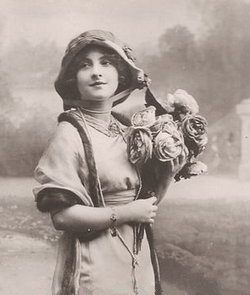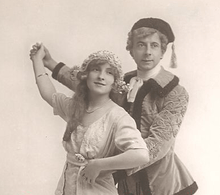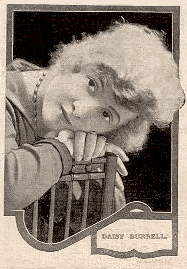Daisy Burrell

Daisy Burrell (born 16 June 1893, living 1947) was an English stage actress and musical theatre performer who also appeared as a leading lady in silent films and in pantomime.
Life and career
Burrell was born in Singapore in 1893.[1] She studied at the Guildhall School of Music in London.[2]
Early career
She first appeared on stage at the London Hippodrome in July 1903, playing the part of Kitty in The Redskins, a water spectacular by Alicia Ramsey.[3][4] On leaving school, she went into pantomime at the Theatre Royal, Drury Lane, and first came to wide attention in 1910, appearing at the Vaudeville Theatre in The Girl in the Train. After closing in London this production, starring Burrell, went on tour until 1911.[5]
After that she was with George Edwardes's touring company for six years, appearing in the hit Edwardian musical comedies The Marriage Market, Peggy, The Sunshine Girl and others.[3][6] In The Marriage Market, she played a midshipman.[7] In 1912 she sang the part of Juliette in a production of Franz Lehár's operetta The Count of Luxembourg,[8][9] and the next year appeared in his Gipsy Love.[10] She played a boy, David Playne, in the original cast of Lonsdale, Unger, and Rubens's new musical Betty,[11] which opened at the Prince's Theatre, Manchester on Christmas Eve, 1914, and transferred to Daly's Theatre in the West End on 24 April 1915.[12]
Films and later career

Burrell's first screen role came in The Valley of Fear (1916), an early Sherlock Holmes film, in which she was the leading lady.[13] She was offered the part after the producer G. B. Samuelson saw her playing Cinderella at the London Palladium.[1] Burrell was represented by Julian Wylie, who boasted in The Stage Year Book: "During 1916 I made Contracts for the following Artistes: Bairnsfather's "Fragments from France", Daisy Burrell, Gladys Cooper, Phyllis Dare, ... Mabel Love ... Vesta Tilley, Madge Titheradge &c. &c."[14] Several other film roles followed. In her second film, Just a Girl (1916), she plays the Australian heiress Esmeralda, who spurns an English lord (played by Owen Nares) to marry a miner.[15] In a 1917 film of Little Women she was Amy, the youngest of the four girls. In April 1920, a theatrical gossip column described her as "Miss Daisy Burrell, the well-known musical comedy star".[16] Later the same year The Straits Times called her "Daisy Burrell, the golden-haired film star".[1] In The Last Rose of Summer (1920), "a melodramatic tale of a spinster betrayed for the sake of a valuable tea set", she again had a leading role.[17] In December 1920 she received good reviews for her part in The Pride of the Fancy, a silent film about a champion boxer.[18]
During her years on the silver screen, Burrell continued to appear on stage. On 23 November 1916 she took part in the inaugural performance at the new St Martin's Theatre, the first night of Fred Thompson's extravaganza Houp La!, playing Aggie,[19] and this production ran until late February 1917.[20] In April 1917 she opened in a revue called £150 at the Ambassadors Theatre.[21] In the spring and summer of 1919 she played Mollie Maybud in Nobody's Boy at the Garrick Theatre.[22] In May 1919 she was the cover girl for an issue of the magazine Pictures and Picturegoer.[23]
In 1920 Burrell returned to pantomime in the title role of Julian Wylie and James W. Tate's Cinderella at the Empire Theatre, Sheffield, continued in 1921 at the Empire, Cardiff, with Stanley Lupino.[24] From December 1922 to March 1923 she appeared again as Cinderella for Wylie & Tate at the London Hippodrome, opposite Clarice Mayne as Prince Charming and Lupino as Buttons, this production running to 176 performances.[25] The Times said of Burrell's Cinderella "She sings, dances and acts with equal ease."[26]
In May 1924 Burrell entered a competition promoted by the sculptor and Royal Academician F. W. Pomeroy (1856–1924), who had offered a prize "for the most perfect pair of feet". She tied with the dancer Margery Prince for the first prize of £50, and The Miami News reported that Burrell had been chosen eight times to play Cinderella on account of the daintiness of her feet.[27] Pomeroy died on 26 May.[28]

In July 1924 she joined a touring company for George M. Cohan's musical Little Nellie Kelly. By this point in her stage career she was represented by the Akerman May Agency, of 16 Green Street, London WC2.[3] Who Was Who in the Theatre, 1912–1976 records no performances for Burrell after 1924.[3] However, Palmer's British Film Actors' Credits, 1895–1987 identifies her with the Daisy Burrell who played two minor parts in the British films Woman to Woman (1946) and Green Fingers (1947), as does the online database of the British Film Institute.[29] Neither publication explains her disappearances from the record in 1924 and again in 1947.
The National Portrait Gallery in London has fourteen portrait photographs of Burrell by Bassano, dated between 1919 and 1922. Several of these are in Cinderella costume, and four include Clarice Mayne.[30]
Filmography
Burrell appeared in the following films: [29]
- The Valley of Fear (1916) – Ettie Shafter[31]
- Just a Girl (1916) – Esmeralda
- It's Always the Woman (1916) – Mrs Sterrington
- Little Women (1917) – Amy March
- The Bridal Chair (1919) – Jill Hargreaves[32]
- Convict 99 (1919) – Geraldine Lucas[33]
- The Artistic Temperament (1919)
- The Pride of the Fancy (1920) – Kitty Ruston[34]
- The Last Rose of Summer (1920) – Lotus Devine[35]
- Woman to Woman (1946) – Stage Box Committee
- Green Fingers (1947) – Stone's receptionist
References
- ↑ 1.0 1.1 1.2 The Straits Times dated 2 November 1920, p. 8
- ↑ "The Guildhall School of Music", The Musical Times, Vol. 58, No. 890 (April 1917), p. 177 (subscription required)
- ↑ 3.0 3.1 3.2 3.3 Who Was Who in the Theatre, 1912–1976: a biographical dictionary of actors, actresses, directors, playwrights, and producers of the English-speaking theatre, vol. 1 (Gale Research Co., 1978), p. 339
- ↑ Walter James MacQueen-Pope, The melodies linger on: the story of music hall (1950): "The Bandits was followed by The Redskins in which Indians in canoes shot rapids seventy feet high, or deep"; 'London Hippodrome', in Marquee, vols. 25–26 (Theatre Historical Society, 1993): "water spectacles which made history at the Hippodrome were "Siberia," "The Bandits," "Tally Ho," "The Redskins" (in which a one-legged diver plunged into the seething waters below from a height of 30 feet)"
- ↑ Swansea Grand Theatre Archive 1911–1925 at swanseasgrand.co.uk, accessed 22 January 2012
- ↑ Who's Who in the Theatre (Pitman, 1930), p. 135
- ↑ Phyllis Ismay Inshaw Rodway, Lois Harford Slingsby, Philip Rodway and a tale of two theatres (1934), p. 239: "The Cinderella of the season, Daisy Burrell, had been hitherto unassociated with such a part, as her latest appearance in Birmingham had been that of a midshipman in The Marriage Market."
- ↑ W. J. MacQueen-Pope, Shirtfronts and sables: a story of the days when money could be spent (Hale, 1953), p. 59
- ↑ Daisy Burrell at Scottish Theatre Archive, accessed 16 January 2012
- ↑ Rodway & Slingsby (1934), p. 177.
- ↑ W. J. MacQueen-Pope, Nights of Gladness (1956), p. 192
- ↑ Betty Original Cast at halhkmusic.com, accessed 15 February 2012
- ↑ R. Haydock, Deerstalker!: Holmes and Watson on screen (1978), p. 38
- ↑ The Stage Year Book (1917), p. xv
- ↑ Robert Connelly, Jay Robert Nash, Stanley Ralph Ross, Motion Picture Guide Silent Film 1910–1936 (1988), p. 132: "Just a Girl** (1916, Brit.) 7 reels Samuelson/Moss bw Owen Nares (Lord Trafford), Daisy Burrell (Esmeralda), J. Hastings Batson (The Duke), Minna Grey (The Duchess), Paul England (The Miner). In another of those British social-class soap operas, an Australian heiress rejects an impoverished lord to marry the miner she really loves. d, Alexander Butler; w, Harry Engholm (based on the novel by Charles Garvice)."
- ↑ Fra Diavolo, 'Theatre Gossip' in Marlborough Express newspaper dated 3 April 1920, p. 6
- ↑ Kenton Bamford, Distorted images: British national identity and film in the 1920s (1999), p. 8
- ↑ 'The Film World' in The Times, issue 42598, 20 December 1920, p. 8, col. C; "Films of the Week", The Times, issue 42968, 1 March 1922, p. 8, col. C
- ↑ J. P. Wearing, The London stage, 1910–1919: a calendar of plays and players, vol. 1 (Scarecrow Press, 1982), p. 542
- ↑ "Theatres" in The Times dated 24 February 1917, p. 8
- ↑ "Theatrical Plans: Last Performances and New Revues", The Times, issue 41453 dated 16 April 1917, p. 11, col. E
- ↑ "The 'Old Mogul' in New Guise Mr. Huntley Wright's Return"' The Times, issue 42088 dated 1 May 1919, p. 15, col. D; The Times, issue 42147, 9 July 1919, p. 12, col. F
- ↑ Pictures and Picturegoer magazine dated 10–17 May 1919 (cover, illustrated)
- ↑ "The Impresarios: Wylie-Tate" at Its-behind-you.com, accessed 15 January 2012
- ↑ 'Cinderella. Hippodrome Theatre, London', in cin8 at lib.rochester.edu, accessed 16 January 2012: "Opened 21 December 1922 to March 1923. 176 performances... Cast: Daisy Burrell (Cinderella)..."
- ↑ 'Cinderella's Slipper. New Pantomime Incident at the Hippodrome' in The Times, issue 43221 dated 22 December 1922, p. 8, col. A
- ↑ The Miami News dated 29 May 1924, p. 9, col. 2
- ↑ 'POMEROY, F. W., RA 1917 (ARA 1906)' in Who Was Who 1916–1928 (London: A. & C. Black, 1992 reprint; ISBN 0-7136-3143-0): "died 26 May 1924"
- ↑ 29.0 29.1 Daisy Burrell at bfi.org.uk, accessed 19 January 2012; Scott Palmer, British Film Actors' Credits, 1895–1987 (McFarland, 1988), p. 102
- ↑ Daisy Burrell portraits at npg.org.uk, accessed 15 January 2012
- ↑ Scott Allen Nollen, Sir Arthur Conan Doyle at the Cinema (1996), p. 255
- ↑ Robert B. Connelly, The silents: silent feature films, 1910–36, vol. 40 (December Press, 1998), p. 35
- ↑ Connelly (1998), p. 334
- ↑ Connelly (1998), p. 219
- ↑ Jay Robert Nash, Robert Connelly, Stanley Ralph Ross, Motion Picture Guide Silent Film 1910-1936 (1988), p. 145
External links
| Wikimedia Commons has media related to Daisy Burrell. |
- Daisy Burrell at the Internet Movie Database
- Daisy Burrell at BFI Film & TV Database
- Daisy Burrell at citwf.com (Complete Index to World Film)
- Daisy Burrell at Scottish Theatre Archive
- Daisy Burrell portraits at npg.org.uk (National Portrait Gallery, London)
- Daisy Burrell at picturegoer.net